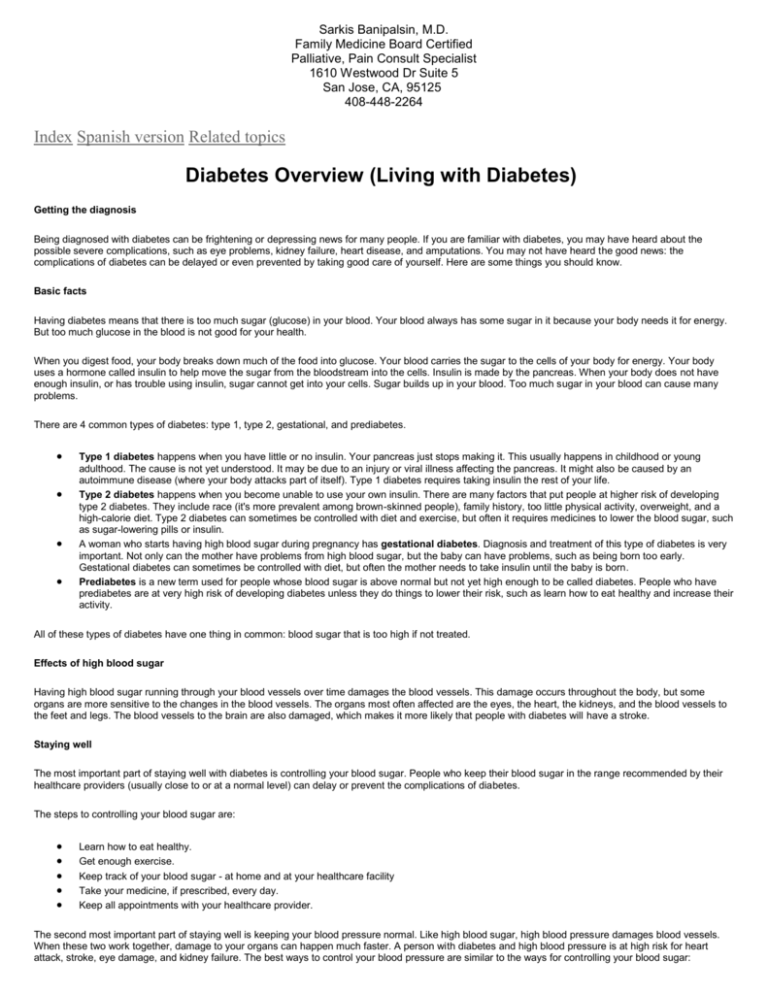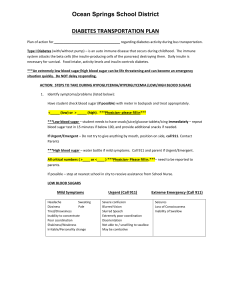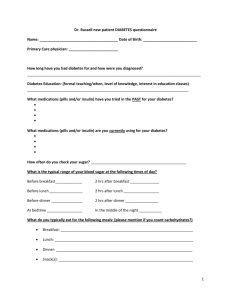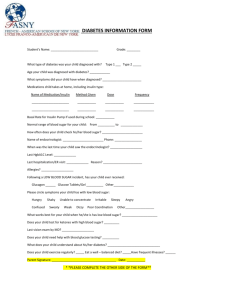
Sarkis Banipalsin, M.D.
Family Medicine Board Certified
Palliative, Pain Consult Specialist
1610 Westwood Dr Suite 5
San Jose, CA, 95125
408-448-2264
Index Spanish version Related topics
Diabetes Overview (Living with Diabetes)
Getting the diagnosis
Being diagnosed with diabetes can be frightening or depressing news for many people. If you are familiar with diabetes, you may have heard about the
possible severe complications, such as eye problems, kidney failure, heart disease, and amputations. You may not have heard the good news: the
complications of diabetes can be delayed or even prevented by taking good care of yourself. Here are some things you should know.
Basic facts
Having diabetes means that there is too much sugar (glucose) in your blood. Your blood always has some sugar in it because your body needs it for energy.
But too much glucose in the blood is not good for your health.
When you digest food, your body breaks down much of the food into glucose. Your blood carries the sugar to the cells of your body for energy. Your body
uses a hormone called insulin to help move the sugar from the bloodstream into the cells. Insulin is made by the pancreas. When your body does not have
enough insulin, or has trouble using insulin, sugar cannot get into your cells. Sugar builds up in your blood. Too much sugar in your blood can cause many
problems.
There are 4 common types of diabetes: type 1, type 2, gestational, and prediabetes.
Type 1 diabetes happens when you have little or no insulin. Your pancreas just stops making it. This usually happens in childhood or young
adulthood. The cause is not yet understood. It may be due to an injury or viral illness affecting the pancreas. It might also be caused by an
autoimmune disease (where your body attacks part of itself). Type 1 diabetes requires taking insulin the rest of your life.
Type 2 diabetes happens when you become unable to use your own insulin. There are many factors that put people at higher risk of developing
type 2 diabetes. They include race (it's more prevalent among brown-skinned people), family history, too little physical activity, overweight, and a
high-calorie diet. Type 2 diabetes can sometimes be controlled with diet and exercise, but often it requires medicines to lower the blood sugar, such
as sugar-lowering pills or insulin.
A woman who starts having high blood sugar during pregnancy has gestational diabetes. Diagnosis and treatment of this type of diabetes is very
important. Not only can the mother have problems from high blood sugar, but the baby can have problems, such as being born too early.
Gestational diabetes can sometimes be controlled with diet, but often the mother needs to take insulin until the baby is born.
Prediabetes is a new term used for people whose blood sugar is above normal but not yet high enough to be called diabetes. People who have
prediabetes are at very high risk of developing diabetes unless they do things to lower their risk, such as learn how to eat healthy and increase their
activity.
All of these types of diabetes have one thing in common: blood sugar that is too high if not treated.
Effects of high blood sugar
Having high blood sugar running through your blood vessels over time damages the blood vessels. This damage occurs throughout the body, but some
organs are more sensitive to the changes in the blood vessels. The organs most often affected are the eyes, the heart, the kidneys, and the blood vessels to
the feet and legs. The blood vessels to the brain are also damaged, which makes it more likely that people with diabetes will have a stroke.
Staying well
The most important part of staying well with diabetes is controlling your blood sugar. People who keep their blood sugar in the range recommended by their
healthcare providers (usually close to or at a normal level) can delay or prevent the complications of diabetes.
The steps to controlling your blood sugar are:
Learn how to eat healthy.
Get enough exercise.
Keep track of your blood sugar - at home and at your healthcare facility
Take your medicine, if prescribed, every day.
Keep all appointments with your healthcare provider.
The second most important part of staying well is keeping your blood pressure normal. Like high blood sugar, high blood pressure damages blood vessels.
When these two work together, damage to your organs can happen much faster. A person with diabetes and high blood pressure is at high risk for heart
attack, stroke, eye damage, and kidney failure. The best ways to control your blood pressure are similar to the ways for controlling your blood sugar:
Keep track of your blood pressure--at home and at your healthcare facility.
Follow your provider's recommendation for limiting the salt in your diet.
Exercise according to your provider's exercise plan for you.
Keep a healthy weight. (Ask your provider to help you determine a healthy weight for you.)
Do not drink a lot of alcohol (no more than 1 drink a day for women and no more than 2 for men).
Take your blood pressure medicine, if prescribed, every day.
Keep your blood pressure checkups with your provider.
The third part to staying well is to try to prevent infection. People who have diabetes are more susceptible to infection. Do these things to stay healthy:
Check your skin, especially your feet (top and bottom) every day for sores, blisters, or other injuries. Report any problems to your provider right
away for prompt treatment.
Keep your blood sugar normal (bacteria and fungus, which can cause infections, thrive on high sugars).
Stay up to date on all of your shots, especially tetanus, pneumonia , and your annual flu shots
Get a tuberculosis (TB) test every year.
Finally, an important part of staying well is avoiding as much stress as possible. Stressful events or situations affect the body's hormones. One hormone in
particular, cortisol, increases blood sugar. Stress also makes your blood pressure rise. If stress is a part of your life, find ways to lower your stress level.
Reducing your stress can take many forms, such as exercise, counseling, better money management, and family meetings. Reducing your stress will help
you control your blood sugar and stay healthy.
For more information, see the Web site for the American Diabetes Association at http://www.diabetes.org/home.jsp and the National Diabetes Information
Clearinghouse Web site at http://diabetes.niddk.nih.gov/index.htm.
Blood Glucose Test
What is the blood glucose test?
This test measures the amount of glucose (sugar) in your blood. Sugar is an important source of energy, especially for the brain. The amount of glucose in
your blood is carefully controlled by the endocrine (glandular) system. This system causes sugar to be stored or used for energy, depending on the needs of
your body.
You can get glucose directly from some foods, such as table sugar. Your body also produces glucose when other foods, especially carbohydrates such as
bread and cereal, are digested.
Why is this test done?
The most common use of the blood glucose test is to check for diabetes mellitus.
How do I prepare for this test?
The simplest way to check for diabetes is to check your blood sugar (glucose) before you've had anything to eat or drink in the morning. In most cases you
will fast overnight, eating nothing and drinking nothing but water after your evening meal and in the morning before your blood is drawn.
If you do shift work, it's best to have your blood checked after your usual sleeping time (at least 6 hours) and before you start your active day. When you wake
up, you should have nothing to eat and nothing to drink except water before your blood is drawn.
You may need to avoid taking certain medicines before the test because they might affect the test result. Make sure your healthcare provider knows about
any medicines, herbs, or supplements that you are taking. Don't stop any of your regular medicines without first consulting with your healthcare provider.
Talk to your healthcare provider if you have any questions.
How is the test done?
Your healthcare provider may poke your finger with a lancet and fill a small tube with the blood. Or a small amount of blood may be taken from your arm with
a needle. The blood is sent to a lab.
Having this test will take just a few minutes of your time. There is no risk of getting AIDS, hepatitis, or any other blood-borne disease from this test.
How will I get the test result?
Ask your healthcare provider when and how you will get the result of your test.
What does the test result mean?
The normal fasting blood glucose range for adults in most labs is 70 to 99 milligrams per deciliter (3.9 to 5.5 millimoles per liter). The normal range may vary
slightly from lab to lab. Normal ranges are usually shown next to your results in the lab report.
A fasting blood sugar level of 100 to 125 mg/dL (5.5 to 6.9 mmol/L) is called impaired fasting glucose or prediabetes. A level of 126 mg/dL (7.0 mmol/L) or
higher can mean you have diabetes.
Your blood glucose level may be higher than normal (a condition called hyperglycemia) if:
You have prediabetes, a condition that can become diabetes.
You have diabetes.
You have previously diagnosed diabetes and:
o you have not been taking insulin or diabetes medicines, or your diabetes medicines are not adequately controlling your condition
o you have not been following a diabetic diet.
You have gestational diabetes. This is a type of diabetes that can occur during pregnancy. It usually goes away after delivery but can come back
years later.
You have kidney or liver disease.
Your pancreas is inflamed.
Your body is severely stressed from an illness, infection, or injury.
You are taking medicine, such as steroids (Prednisone), which can raise your blood sugar.
Your blood glucose level may be lower than normal (called hypoglycemia) if:
You are diabetic and:
o The dose of insulin or other medicine used to control your diabetes is too high.
o You took your medicine for diabetes but then did not eat.
Your thyroid, pituitary, or adrenal glands are not working normally.
You have liver disease.
You have problems absorbing food.
You are not getting the nutrients you need from your diet.
What if my test result is not normal?
Test results are only one part of a larger picture that takes into account your medical history and current health. Sometimes a test needs to be repeated to
check the first result. Talk to your healthcare provider about your result and ask questions.
If your test results are not normal, ask your healthcare provider:
if you need additional tests
what you can do to work toward a normal value
when you need to be tested again.
Written by Tom Richards, MD, for RelayHealth.
Published by RelayHealth.
Last modified: 2009-08-13
Last reviewed: 2009-03-29
This content is reviewed periodically and is subject to change as new health information becomes available. The information is intended to inform and
educate and is not a replacement for medical evaluation, advice, diagnosis or treatment by a healthcare professional.
Adult Health Advisor 2009.4 Index
© 2009 RelayHealth and/or its affiliates. All Rights Reserved.
A1C Test
What is the A1C test?
The A1C ("A-one-C") test is a blood test used in the care of people who have diabetes. The A1C percentage is a way of looking at your average blood sugar
control over the last 2 or 3 months.
Sugar absorbed from your digestive system circulates in the bloodstream. When the blood sugar is high, the sugar attaches to the hemoglobin protein in red
blood cells, forming A1C.
Red blood cells live 90 to 120 days. This means that once sugar has combined with the hemoglobin in red blood cells, the A1C stays in the blood for 90 to
120 days. This means the amount of A1C in your blood reflects how often and how high your blood sugar has been over the past 3 months.
Another name for this test is A1C hemoglobin test.
Why is this test done?
A1C is an excellent way to check how well you are controlling your blood sugar over a 3-month period.
A1C measurements are important because:
They confirm your daily home blood sugar results and your testing schedule.
They help predict your risk of diabetic complications. The higher the A1C percentage, the greater the risk of developing diabetic eye, kidney,
cardiovascular, and nervous system disease.
How do I prepare for this test?
No preparation is necessary. One of the advantages of this test is that you do not have to fast before you take it.
How is the test done?
A small amount of blood is taken from your arm with a needle. The blood is collected in tubes and sent to a lab.
Having this test will take just a few minutes of your time. There is no risk of getting AIDS, hepatitis, or any other blood-borne disease from this test.
At some pharmacies you may be able to buy a device that allows you to test A1C at home. You may find that the results of the home test are not the same as
results of tests done at your provider's office.
How will I get the test result?
Ask your healthcare provider when and how you will get the result of your test.
What does the test result mean?
The A1C percentage rises as your average blood sugar level rises.
The normal range for a person without diabetes is 4 to 6%.
The goal for most adults with diabetes is an A1C below 7%. For some people the goal should be 6%. For others, the A1C goal may need to be
slightly higher than 7% (for example, the very elderly).
The following chart shows examples of how the A1C is related to your average blood sugar level:
A1C
Average Blood Sugar
----------------------------------------6%
126 mg/dL (7.0 mmol/L)
7%
154 mg/dL (8.6 mmol/L)
8%
183 mg/dL (10.2 mmol/L)
9%
212 mg/dL (11.8 mmol/L)
10%
240 mg/dL (13.4 mmol/L)
-----------------------------------------Remember that, even though you have this test every 2 or 3 months, you need to keep testing your blood sugar as often as your provider recommends.
What if my test result is not normal?
If you have not yet been diagnosed with diabetes and your test is not normal, you need to talk with your healthcare provider about whether you have
diabetes.
If you have been diagnosed as diabetic and your test is not normal, your healthcare provider will talk to you about how to lower your blood sugar through diet,
exercise, and/or medicine. Keeping your blood sugar levels and A1C levels in or near normal ranges will help you avoid the complications of diabetes, such
as eye disease, kidney disease, or nerve damage.
If your test results are not normal, ask your healthcare provider:
if you need additional tests
what you can do to work toward a normal value
when you need to be tested again.
The A1C test should be done every 3 months unless you are in good control. If you do have good control of your blood sugar, your provider may recommend
having the test every 6 months.
Developed by RelayHealth.
Published by RelayHealth.
Last modified: 2009-08-14
Last reviewed: 2009-03-29
This content is reviewed periodically and is subject to change as new health information becomes available. The information is intended to inform and
educate and is not a replacement for medical evaluation, advice, diagnosis or treatment by a healthcare professional.
Adult Health Advisor 2009.4 Index
© 2009 RelayHealth and/or its affiliates. All Rights Reserved.
McKesson is a service mark of McKesson, Inc.






